 W
WThe Arsenal Firearms AF2011-A1 is a double-barreled, semi-automatic pistol of Italian origin. The weapon is a derivative of the M1911 pistol and the majority of internal parts including the firing pins, firing pin plates, sear groups, springs, recoil rods, and mainspring housings are interchangeable with standard M1911 replacement parts. The purpose of the AF2011A1 pistol is to increase the ballistic capability of .45 ACP without the need to develop a more powerful round. The AF2011A1 has its roots in the Grieco pistol that also came with double barrels for the same purpose.
 W
WThe One-Pro 45 is a semi-automatic pistol chambered in .45 ACP and manufactured in Wettingen, Switzerland. It was at one time imported into the United States by Magnum Research and into Italy by ALGIMEC.
 W
WThe Astra A-100 is a Spanish double-action/single-action semi-automatic pistol that was manufactured by Astra-Unceta y Cia SA beginning in 1990. It was distributed in the United States by European American Armory (EAA). The A-100 is also known as the "Panther" as imported into the United States by Springfield Armry, and some specimens have this roll-marked on the left of the slide. The A-100 design is a further development of Astra's earlier A-80 and A-90 models. The A-80 was originally patterned after the SIG P220.
 W
WThe Ballester–Molina is a pistol designed and built by the Argentine company Hispano Argentina Fábrica de Automóviles SA (HAFDASA). From 1938 to 1940 it bore the name Ballester–Rigaud.
 W
WThe Beretta 8000 (Cougar) series pistols are manufactured by Beretta of Italy.
 W
WThe Beretta Px4 Storm is a semi-automatic pistol manufactured by Beretta of Italy and intended for personal defense and law enforcement use. The Px4 uses the same short-recoil, rotating barrel action as the Beretta 8000 and uses the same trigger and safety system as the Beretta 92, while being completely different in design from either.
 W
WThe Thunder 9 is a full size semi-automatic handgun manufactured by Bersa at the Ramos Mejia production plant in Argentina. It is also sold under the name Firestorm or FS 9.
 W
WIn 1977 Browning introduced four models of their Browning BDA handgun. These guns came in two frame sizes from two different makers. The large frame handgun was made in three calibers; 9x 19mm Parabellum, .38 Super, and .45 ACP. The guns were sold from 1977 until 1980. These guns were made in Germany by Sig-Sauer.
 W
WThe BUL M-5 is a M1911 clone pistol made by Israeli firearms manufacturer BUL Transmark. M-5s are made in "carry" models for personal defense and "competition" models for sporting use.
 W
WThe Colt Commander is a single-action, semi-automatic, magazine-fed, and recoil-operated handgun based on the John M. Browning designed M1911. It was the first mass-produced pistol with an aluminium alloy frame and the first Colt pistol to be chambered in 9mm Parabellum.
 W
WThe Colt Double Eagle is a double-action / single action, semi-automatic pistol manufactured by Colt's Manufacturing Company between 1989 and 1997. It was the first double-action semiautomatic pistol offered by the company and was available in standard full-size, as well as in more compact versions. It featured a decocking lever, and was chambered for several calibers. The family of models was known as the Series 90.
 W
WThe Colt Officer's Model or Colt Officer's ACP is a single-action, semi-automatic, magazine-fed, and recoil-operated handgun based on the John M. Browning designed M1911. It was introduced in 1985 as a response from Colt to numerous aftermarket companies making smaller versions of the M1911 pistol.
 W
WThe CZ 97B is a semi-automatic handgun introduced in 1997 in the .45 ACP caliber. The CZ 97B is essentially the CZ 75B in .45 ACP rather than 9mm, leading many gun enthusiasts to call the 97B the "big brother" to the very popular CZ 75B.
 W
WThe Dan Wesson M1911 pistol is a series of model 1911 semi-automatic pistols.
 W
WThe FN FNP pistol is a series of semi-automatic, polymer-framed pistols manufactured in Columbia, South Carolina, by FNH USA, a division of Fabrique Nationale de Herstal. The pistol debuted in early 2006 and is chambered for the 9×19mm Parabellum, .40 S&W, .45 ACP, and .357 SIG cartridges.
 W
WThe FN FNX pistol is a series of semi-automatic, polymer-framed pistols manufactured in Columbia, South Carolina, by FN America, a division of Fabrique Nationale d'Herstal. The pistol is chambered for the 9×19mm Parabellum, .40 S&W, and .45 ACP cartridges.
 W
WThe Glock is a series of polymer-framed, short recoil-operated, locked-breech semi-automatic pistols designed and produced by Austrian manufacturer Glock Ges.m.b.H. The firearm entered Austrian military and police service by 1982 after it was the top performer in reliability and safety tests.
 W
WThe AMT Hardballer is a series of pistols that are a clone of the .45 ACP Colt M1911 made by Arcadia Machine & Tool (AMT) from 1977 to 2002. The Hardballer was the first entirely stainless steel 1911 pattern pistol. Other features included adjustable rear sights and a lengthened grip safety.
 W
WThe Heckler & Koch HK45 is a semi-automatic pistol designed by the German arms manufacturer Heckler & Koch.
 W
WThe Heckler & Koch MK 23, MK 23 MOD 0, Mark 23, or USSOCOM MARK 23 is a semi-automatic large-frame pistol chambered in .45 ACP, designed specifically to be an offensive pistol. The USSOCOM version of the MK23 came paired with a laser aiming module (LAM) and suppressor. The USSOCOM MK23 was adopted by the United States Special Operations Command (USSOCOM) for special operations units, beating out the nearest competitor, Colt's OHWS. Development of the pistol began in 1991 as special operations representatives identified the need for an "Offensive Handgun Weapons System—Special Operations Peculiar", and delivery of the pistols began in May 1996 to the special operation units.
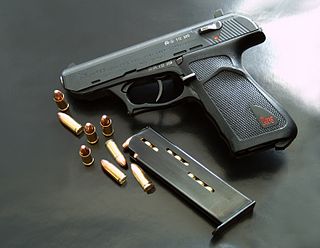 W
WThe HK P9 is a semi-automatic pistol from Heckler & Koch in 9×19mm Parabellum and the first to use a variation of H&K's roller delayed blowback system in a pistol format and polygonal rifling now common in H&K designs.
 W
WThe USP is a semi-automatic pistol developed in Germany by Heckler & Koch GmbH (H&K) of Oberndorf am Neckar as a replacement for the P7 series of handguns.
 W
WThe Hi-Point Model JHP is a polymer-framed, semi-automatic, blowback-operated pistol manufactured by Hi-Point Firearms.
 W
WThe HS2000 is a series of semi-automatic pistols. Polymer-framed and striker-fired, the series is manufactured by HS Produkt in Karlovac, Croatia. In Europe, the pistols are marketed as the HS and XDM series, while in the United States, the pistols are sold as the Springfield Armory XD and XD-M series, respectively. Other derivative variants sold by Springfield Armory, Inc., are unique to the American market.
 W
WThe Jericho 941 is a double-action/single-action semi-automatic pistol developed by Israel Military Industries that was launched in 1990.
 W
WThe JO.LO.AR. was a semi-automatic pistol of Spanish origin and is chambered in various calibres. It is a development of the Extractor Model Sharpshooter pistol and was manufactured from 1924 by Bonifacio Echeveria STAR, with patent by J. Lopez de Arnaiz and renamed the JO-LO-AR, hence the designer's initials.
 W
WThe Kahr P series is a product line of double action only (DAO) hammerless, striker-fired, short recoil operated, semi-automatic pistols manufactured by Kahr Arms. The target market for the P line is the civilian concealed carry firearms market, as well as being intended as backup weapons for law enforcement officers.
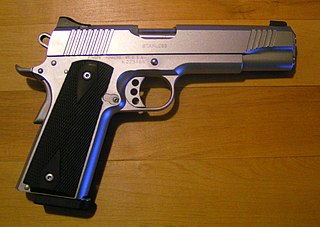 W
WThe Kimber Custom is an M1911 style semi-automatic pistol. It is designed, manufactured, and distributed by Kimber Manufacturing, Inc. in Yonkers, New York.
 W
WThe Kongsberg Colt is a nickname used for Colt M1911 pistols produced under license by the Norwegian factory Kongsberg Vaapenfabrikk.
 W
WThe Grizzly Win Mag pistols were conceived, invented, designed, engineered and developed in the 1980s by the sole inventor, Perry Arnett, who licensed his patent for an interchangeable caliber semi-automatic pistol to L.A.R. Manufacturing Inc. Perry Arnett's designs were initially flawed and were improved upon by Heinz Augat. The L.A.R. Grizzly was the most powerful semi-automatic pistol ever commercially produced.
 W
WThe M15 General Officers is a .45 ACP pistol developed by the U.S. Army's Rock Island Arsenal from stock M1911 pistols as a replacement for the aging Colt Model 1903 and Model 1908 Pocket Hammerless pistols. The pistol was issued to United States Army general officers as a personal weapon.
 W
WThe M1911, also known as the Colt 1911, or the Colt Government, is a single-action, semi-automatic, magazine-fed, recoil-operated pistol chambered for the .45 ACP cartridge. It served as the standard-issue sidearm for the United States Armed Forces from 1911 to 1985. It was widely used in World War I, World War II, the Korean War, and the Vietnam War. The pistol's formal designation as of 1940 was Automatic Pistol, Caliber .45, M1911 for the original model of 1911 or Automatic Pistol, Caliber .45, M1911A1 for the M1911A1, which was adopted in 1924. The designation changed to Pistol, Caliber .45, Automatic, M1911A1 in the Vietnam War era.
 W
WThe Mauser C96 is a semi-automatic pistol that was originally produced by German arms manufacturer Mauser from 1896 to 1937. Unlicensed copies of the gun were also manufactured in Spain and China in the first half of the 20th century.
 W
WThe MEU(SOC) pistol, officially designated the M45 MEUSOC, is a magazine-fed, recoil-operated, single-action, semiautomatic pistol chambered for the .45 ACP cartridge. It's a variant of the M1911, and has been the standard-issue side arm for the Force Recon Element of the United States Marine Corps' Marine Expeditionary Units since 1985. Its NATO Stock Number is 1005-01-370-7353.
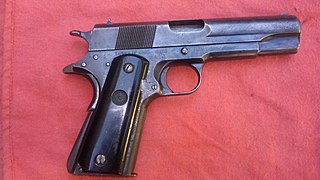 W
WThe Obregón is a Mexican designed semi-automatic pistol designed in the mid-1930s by the mechanical engineer Alejandro Obregón. It uses the same .45 caliber ammunition as the Colt 1911 and it resembles the 1911 in overall appearance, frame size and weight. However it features a rotating barrel locking system. This system employs a diagonal cam on the rear of the barrel sliding against a diagonal receiver-mounted groove that rotates the barrel. This is like the Austro-Hungarian Steyr M1912 pistol, unlike the "swinging link and pin" of the Colt M1911 series.
 W
WThe Remington 1911 R1 is a semi-automatic pistol modeled after the classic Colt 1911 which has served the US armed forces for over 100 years. Like the Colt 1911, the Remington 1911 is single action only, and has a grip safety and a manually operated thumb safety; it also has a Colt Series 80 style firing pin safety.
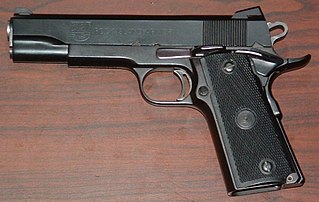 W
WThe Rock Island Armory 1911 series is a product line of single-action recoil operated semi-automatic pistols. They are designed and manufactured by Armscor in Marikina, Philippines, and distributed in the United States by Armscor USA, located in Pahrump, Nevada.
 W
WThe Ruger American Pistol is a polymer-framed, semi-automatic pistol introduced by Ruger in December 2015. The pistol uses a pre-tensioned striker firing system, and is chambered in 9mm Luger and .45 ACP. The pistol uses a Browning-type locked-breech short recoil action, with a barrel cam system that is designed to reduce felt recoil. The serialized part of the pistol is a steel chassis, which is fit to a glass-filled nylon frame. The frame incorporates a Picatinny rail for mounting accessories.
 W
WThe Ruger P series is a line of centerfire semi-automatic pistols made by Sturm, Ruger & Company produced from 1985 to 2013. The P-series pistols were designed for military, police, civilian and recreational use. The designs are largely based on the Browning action found in the M1911 pistol, but with minor variations, generally related to the safety mechanism and the barrel-camblock interface. Reviews have considered them rugged, reliable, and strong, though this strength comes at the price of bulk and a blocky appearance.
 W
WThe Ruger SR1911 is a semi-automatic pistol modeled after the classic Colt M1911 pistol.
 W
WSIG Sauer of Newington, NH United States manufactures a full line of 1911 styled handguns. The earliest models were very faithful to the John M. Browning designed Colt M1911 Pistol which became the United States standard sidearm and served in that capacity for some seven decades before being replaced by the Beretta M9 handgun.
 W
WThe SIG Sauer P220 is a semi-automatic pistol. Designed in 1975 by the SIG Arms AG division of Schweizerische Industrie Gesellschaft, and produced by J. P. Sauer & Sohn, in Eckernförde; it is currently manufactured by both SIG Sauer companies: SIG Sauer GMBH, of Eckernförde, Germany; and SIG Sauer, Inc., of New Hampshire, United States.
 W
WThe SIG Sauer P227 is an American-designed and produced semi-automatic pistol which was introduced in 2013 and discontinued in 2019. The P227 introduced a double-stack .45 ACP caliber handgun into the SIG Sauer lineup. It was introduced along with the P224.
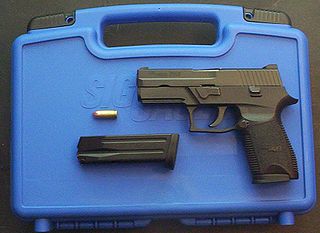 W
WThe SIG Sauer P250 is a semi-automatic pistol made by Sigarms. Introduced in 2007 the SIG P250 can be chambered in .22 Long Rifle, .380 ACP, 9×19mm Parabellum, .357 SIG, .40 S&W, and .45 ACP. The P250 chambered in 9×19mm Parabellum was introduced to the North American market on November 7, 2007 followed by the .45 ACP compact model in February 2008 at the SHOT Show. The last of the models were introduced in late 2009.
 W
WThe SIG Sauer P320 is a modular semi-automatic pistol made by SIG Sauer, Inc. of Exeter, New Hampshire, and SIG Sauer GmbH of Eckernförde, Germany. It is a further development of the SIG Sauer P250, utilizing a striker-fired mechanism in lieu of a double action only hammer system. The P320 can be chambered in 9×19mm Parabellum, .357 SIG, .40 S&W, and .45 ACP, and can be easily converted from one caliber to another—a change from .357 SIG to .40 S&W requires only a barrel change; a change between 9mm to .357 SIG or .40 S&W and vice versa are accomplished using a caliber exchange kit.
 W
WThe Smith & Wesson M&P is a polymer-framed, short recoil operated, locked breech semi-automatic pistol introduced in the summer of 2005 by the American company Smith & Wesson. It uses a Browning-type locking system. While targeted at law enforcement agencies, the M&P is also widely available on the commercial market.
 W
WThe Smith & Wesson Model 457 is a compact semi-automatic pistol from Smith & Wesson's Third Generation series of alloy and steel-framed handguns in company's Value Line of budget-priced auto pistols. The 457 is a compact pistol chambered for the .45 ACP cartridge. The design utilizes a double-action/single action trigger mechanism, meaning that the first shot is fired with long double-action pull, with following shots fired in single-action. The 457's external hammer omits a thumb spur, thereby reducing the risk of being caught on clothing during unholstering. A slide-mounted safety lever that drops the hammer from its cocked position when moved to the 'safe' position. The 457 has a 95 mm (3.75 in) barrel and 7-round magazine capacity. The Model 457 was produced with a matte-finish carbon steel slide and blackened aluminum alloy frame. Other versions include the Model 457S with a stainless steel slide and aluminum frame, and the Model 457TDA with a satin-finished aluminum frame and black carbon steel slide.
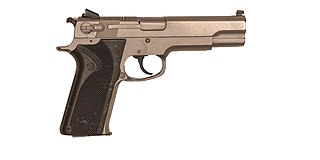 W
WThe Smith & Wesson Model 4506 is a third-generation semi-automatic pistol from Smith & Wesson's 4500 series of handguns. The 4506 is chambered for the .45 ACP cartridge and, with the purchase of special springs, the stronger .45 Super. It is constructed almost entirely from stainless steel and is thus extremely resistant to harsh weather conditions. The 4506 is a traditional double-action/single-action pistol. The first shot is fired in double-action mode. Each subsequent shot is fired in single-action mode. It features one-piece Xenoy wrap-around grips with either a curved or straight back strap. The 4506 was produced from 1988 to 1999.
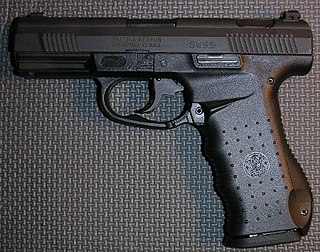 W
WThe SW99 rendition of the popular Walther P99 was the product of a joint collaboration between Smith & Wesson and Walther. The modified receiver used in the SW99 is supplied by Walther and is manufactured in Germany. Smith & Wesson manufactures the slide and barrel of the SW99 in the United States. Though there are slight variations in aesthetic design, the function of the SW99 is identical to its German-made counterpart.
 W
WThe SW1911 is a stainless steel framed, single action, semi-automatic pistol that is based on the M1911, that comes in either 9×19mm or .45 ACP.
 W
WThe Solid Concepts 1911 DMLS is a 3D-printed version of the M1911 pistol. It was made public around November 2013 and was printed via the direct metal laser sintering (DMLS) method. It was created by Solid Concepts. A Solid Concepts Browning M1911 replica fired more than 600 rounds without any apparent damage to the gun. The metal printer used to create the weapon cost between $500,000 to $1,000,000 at the time the gun was created as of November 2013. The first gun, version 1.0, is made up of 34 3D-printed 17-4 stainless steel components.
 W
WThe Springfield Armory XD is a series of semi-automatic pistols sold by Springfield Armory, Inc., in the United States along with follow-on variants: XD-M, XD-S, and XD-E. Polymer-framed and predominantly striker-fired, the series is manufactured by HS Produkt in Karlovac, Croatia.
 W
WThe Star Firestar is a series of single-action semi-automatic pistol consisting of four models that received the 1991 Handgun of the Year Award from Guns & Ammo magazine. The Firestar was available in 9 mm Para (M-43), .40 S&W (M-40), and .45 ACP (M-45) calibers, all having a single-stack magazine. A double-stack 9mm version (M-243) was also available and was commonly referred to by the unofficial name "Firestar Plus". The Firestar was produced by the now defunct Star Bonifacio Echeverria, S.A. in Eibar, Spain until 1994. The Firestar was imported into the United States by Interarms of Alexandria, Virginia.
 W
WThe Star Model PD is a compact and lightweight semi-automatic pistol which was manufactured from 1975 to 1990 by the firearms manufacturing company Star Bonifacio Echeverria, S.A., located in the city of Eibar in the Basque region of Spain.
 W
WThe Tanfoglio Force, also known as Force 99, Force 2002, EAA Witness Polymer or EAA Witness P-Carry, is a modified clone of the Czech CZ-75/CZ-85 semi-automatic pistol. It is made in Gardone Val Trompia near Brescia, Italy by Fratelli Tanfoglio S.N.C..
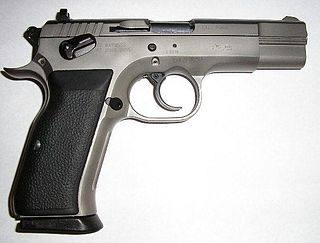 W
WThe Tanfoglio Combat or Standard, also known as T(A)95 or EAA Witness Steel, is a modified clone of the Czech CZ-75/CZ-85 pistol. It is made in Gardone Val Trompia near Brescia, Italy by Fratelli Tanfoglio S.N.C..
 W
WThe Taurus Millennium series is a product line of double-action only (DAO) and single-action/double-action hammerless, striker-fired, short recoil operated, semi-automatic pistols manufactured by Forjas Taurus S/A in Porto Alegre Brazil. The Millennium line was designed to contend in the civilian concealed carry firearms market, and to be sold as backup weapons for law enforcement officers.
 W
WThe Walther PPQ is a semi-automatic pistol developed by the German company Carl Walther GmbH Sportwaffen of Ulm for law enforcement, security forces and the civilian shooting market as a potential replacement for the Walther P99. It is available in .22 Long Rifle, 9×19mm Parabellum, 9×21mm, .40 S&W, and .45 ACP chamberings.
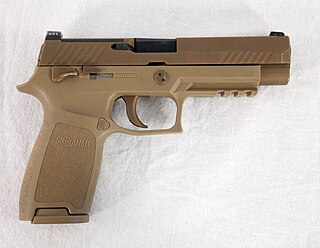 W
WThe XM17 Modular Handgun System (MHS) competition was a United States Army and United States Air Force competition for a new service pistol. The Modular Handgun System was solicited by a Request for Proposals in September 2015 and is anticipated to be the next U.S. military standard side arm replacing the Beretta M9 pistol and the SIG Sauer M11. The U.S. Marine Corps also participated in the program to have input on source selection, but likely will not order the resulting weapon until their current pistols' life-cycles end in the mid-2020s.
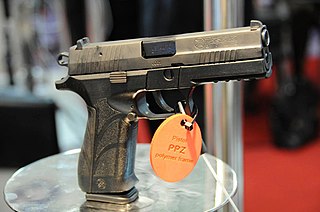 W
WThe Zastava PPZ is the latest generation of the CZ 99 series of handguns chambered in multiple calibers.